Smart sensors can open a window into the environment. In this week's Naked Scientists Podcast we find out how networks of sensors around Heathrow airport can study how planes alter the atmosphere, and how a similar network can monitor an Oxfordshire floodplain. Plus, we find out how the tools of a surgeon are helping to keep jet engines in flying form. In the news, we hear how gut bugs promote blood vessel growth, why fresh fruit and veg gives you a healthy hue and how scientists are analysing antimatter with microwaves...
In this episode
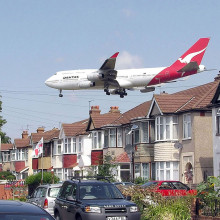
01:30 - Sensing an Airport Environment - SNAQ Heathrow
Sensing an Airport Environment - SNAQ Heathrow
with Dr Iq Mead, Cambridge University
Ben - Sensors are essential for our understanding of the environment around us. Weather stations for example have been collecting data on wind speed, rainfall, pressure and humidity around the world since at least the 1940s. And now, a new project led by the University of Cambridge with a host of university and industry partners, and funded by the Natural Environment Research Council, seeks to deploy a network of sensors around Heathrow airport in order to study the atmosphere with unprecedented resolution. I met Doctor Iq Mead from Cambridge University to find out what it is that they hope to learn.
Iq - This project is really looking at urban air quality in the first instance and then we're trying to tie that into specific science questions within that; specific airport questions such as the dispersion of the buoyant aircraft plume or distribution of sources around an airport, what does it do if you increase the use of one side of the airport versus another, these kinds of things. One of the beauties of this kind of network is that you can disperse it over wide area and in a fairly dense mode, to get a lot more information than you would actually need to answer that particular question, so you can tie the data into other issues as well around it.
Ben - Why airports in particular? Why is an airport more interesting than a city?
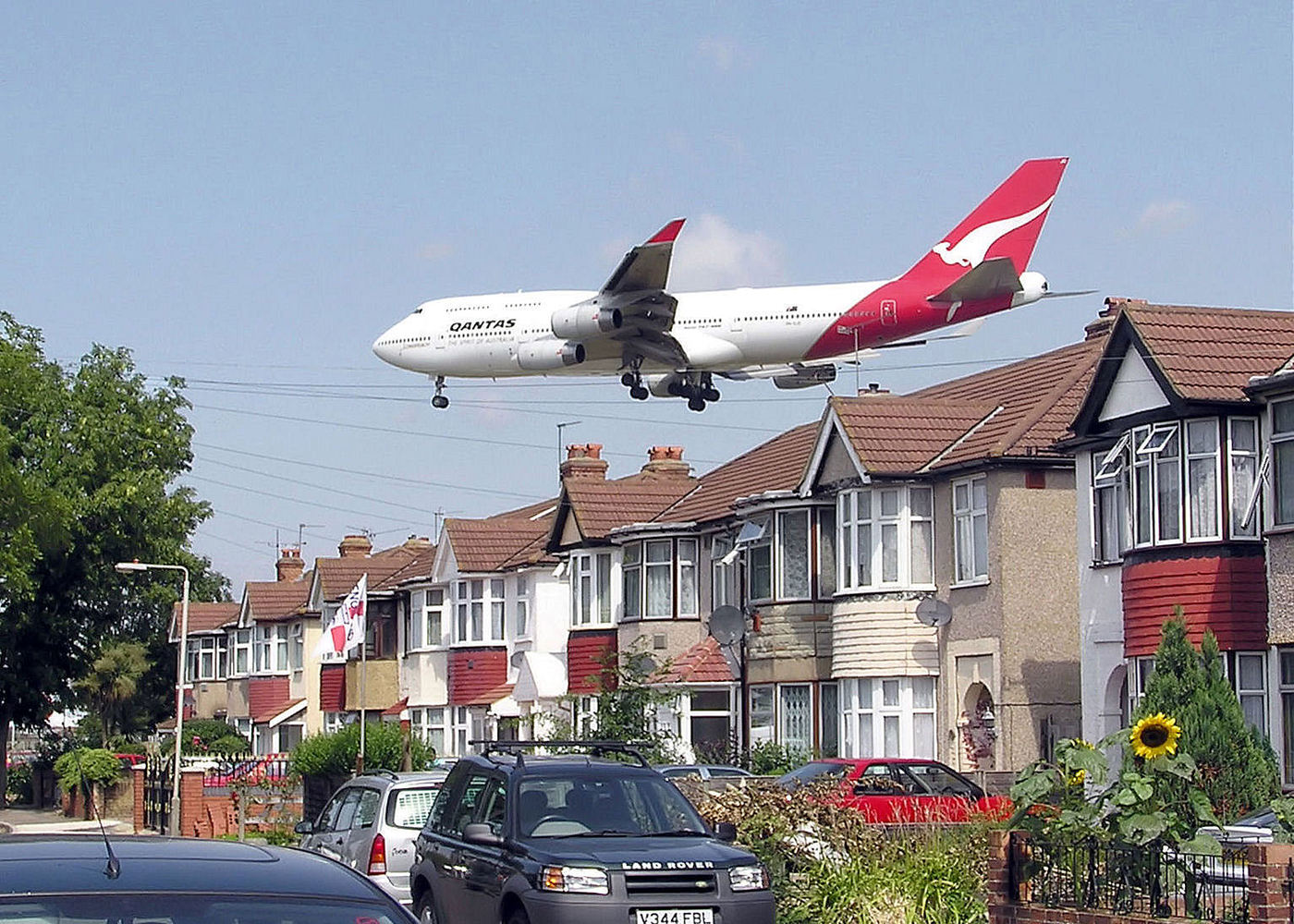 Iq - This project is built on previous projects, looking at urban and rural concentrations in towns and cities in the UK and abroad. So we've deployed in Cambridge, London, Kuala Lumpur, and Lagos. The idea being that we want to understand what's happening in that environment for those particular questions. For Heathrow airport, we have a rather unique situation in that we have a very large airport surrounded by a very large city, and we need to understand what's happening before the airport, as things get into the airport, and what the outflow is from the airport, now that it affects a wider area.
Iq - This project is built on previous projects, looking at urban and rural concentrations in towns and cities in the UK and abroad. So we've deployed in Cambridge, London, Kuala Lumpur, and Lagos. The idea being that we want to understand what's happening in that environment for those particular questions. For Heathrow airport, we have a rather unique situation in that we have a very large airport surrounded by a very large city, and we need to understand what's happening before the airport, as things get into the airport, and what the outflow is from the airport, now that it affects a wider area.
Ben - So what is it that you're actually sensing? What are you picking up?
Iq - Broadly speaking, we're looking at a number of gas phase pollutant species such CO, NO, SO2, ozone, but we're also looking at carbon dioxide, speciated particulates and the wind speed and direction for like particular measurement site. What we can do with that is really understand how the pollutants are moving through our environment, directly tied to where we're making the measurements as opposed to a bulk, "the wind speed is this number of knots and in this direction" and then crudely linking it.
Ben - So each one of your sensors is obviously capable of measuring a large number of different factors. Why do you need to have them in this network? What's important about the structure of the network?
Iq - Actually, the whole thing is a very modular system in as much as it's a collection of sensors in one "sensor node". Those nodes are then put out in a dense network. The key to the network is that we can then start to understand at an appropriate granularity in time and space, the things we're trying to measure. We can do a lot of interesting things with dense networks we couldn't necessarily do with more dispersed networks. For example, the validity of the data we're collecting is essentially tied in to its calibration. If we have a dense network, you can then rollout a calibration to very specific nodes and then they will tell you a lot, or you can infer the behaviour of nearby nodes. So you can take your study for validation across the network without actually having to maybe go to all sites and calibrate them in a traditional way although we will be doing that to some of them.
Ben - So you could for example, if you have one node in between two others and it doesn't quite agree, you know that that one needs calibrating differently because presumably, there will be a gradient across those three.
Iq - Of course, depending on your local sources. It could quite correctly be varying differently to the ones around it. However, if you know that site A to site C is roughly the same source pattern and then site B is in between, you should be able to understand what's happening in site B using site A and C.
Ben - What sort of density are we talking about? How regularly spaced are these sensors?
Iq - It's an irregular network. I mean, in part, we have to be practical. We can't just turn up at an airport and say I want to put a sensor on a lamp post here - it might be in the middle of a runway. What we're going to be doing is locating a number of sensors around the periphery of the airport and then also, dispersed within the airport at strategic points including on the ATC main towers so we get a vertical transect as well. Put it into context, across the UK, there's about 120, 125 static monitoring sites used for air quality as part of the main DEFRA AURN monitoring network and we're going to put in 50 plus sensors across Heathrow alone.
Ben - So that's clearly far more dense than what's gone before it. Presumably, these are all capable of talking to each other and there are ways to collect the information remotely. You don't need to send somebody to every single sensor to pick up its data.
Iq - Well absolutely. I remember when I first started, if you put a sensor out, you had to go and collect the data from it with a cable. These sensors, we're collecting data autonomously and then sending it to a remote server at 2-hourly intervals, I think is the current plan. The idea being that we have all that data coming in semi-real time to us. We can start our analysis on day 2 of deployment and you can really start to understand what's happening, and then you can actually look at your network and say, "Well this sensor is redundant here. Maybe we should move it there, or this is an area of particular interest, we're looking at a particular question, let's see if we could put up a few more sensors there." Augment the network as well as tie it into the existing network because they do work together. Our sensors are not as intrinsically sensitive as the traditional static sites but they more than make up for that in their mobility, and their ability to be put out as this dense networks. It's all about the appropriate scales of measuring for the particular species in question.
Ben - So do you have to design very specific sensors in order to play this multifaceted role of picking up lots of different things and communicating it, and acting as part of a network?
Iq - I suppose what we've done is taken advances in various technologies, and put them together into a sensor node. So, within that upcoming deployment, what we have are a series of electrochemical sensors which were originally designed for a much higher concentration in the industrial sphere. And we started to work with those. They're now coming down and they're just at the point where they're sensitive and selective enough for this kind of application. We also have a photoionization detector, there's a small folded path spectroscopic device looking at CO2 and a sonic anemometer for our wind speed and direction. Put all these things together and the intelligence needed onboard to control all these constituent parts is a large part of the network design, then how to deal with all that data afterwards becomes an even larger part.
Ben - It seems appropriate that you're putting this at an airport because presumably, you face some of the same challenges of the people who build and design aeroplanes where they have to miniaturise and condense all of their sensing equipment as well.
Iq - We do face constraints on things like power and weight. However, they're not quite as acute in as much as it's not going to cost us more in fuel, for example, to carry a larger power pack. But in terms of practicality of a network, you have to take into account the operation and the lifetime of the network. You have to understand that it's going to take a certain amount of power, are you going to be able to scavenge power from local sources, do you have to put power there for it - i.e. big battery. You are under a series of constraints regarding how often you can send data, for example, because switching on an antenna takes quite a lot of power, and each one of these things essentially has a mobile phone on a chip onboard internally. So you have to control how much power you're using and then you have to think about how much data you're sending, the cost associated... These things snowball a lot.
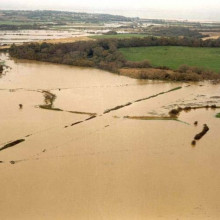
Going Underground to Sense Soil Moisture
with Dr Anne Verhoef, Reading University
Ben - Sensor networks can be deployed in a host of locations to shed some light on how systems change over time. Dr. Anne Verhoef from the University of Reading is using a very similar system to SNAQ Heathrow in order to better understand the relationship between plants, soil and the atmosphere. And Anne joins us now. So Anne, we've just heard about how we're hoping to learn about the environment of an airport. Well what are you hoping to learn with looking at soil and moisture and the atmosphere?
Anne - We're actually still testing our wireless sensor network, but it will be installed in the Thames floodplain north of Oxford and this area is called Yarnton Meads. It's actually a site of special scientific interest, it's an ancient hay meadow. Research began in this area many decades ago because floodplains are a very valuable resource. Here, we have very rare plant species growing up to 40 species per square metre and also, these flood plains perform key ecosystem services such as flood storage and the retention of river sediments. So, it's very important that we improve our understanding of these very rare areas because there's actually only 1500 hectares left of this unique habitat in the UK.
We're really aiming here to measure soil moisture and we're measuring soil temperature because what's happening in these flood plains is that the soil moisture content for example will vary spatially at a very high scale. So if we stand in one part of the field, if we take 10 steps, we could find an area that's much wetter. Here, we don't just have the river water over banking, we actually have the ground water rising and in certain areas where the microtopography is slightly different, we will have plants growing that have their roots in slightly wetter areas for example. So we don't have just the same species growing all over the field. We have areas where we have wet loving species and areas where we have species that like their roots slightly drier.
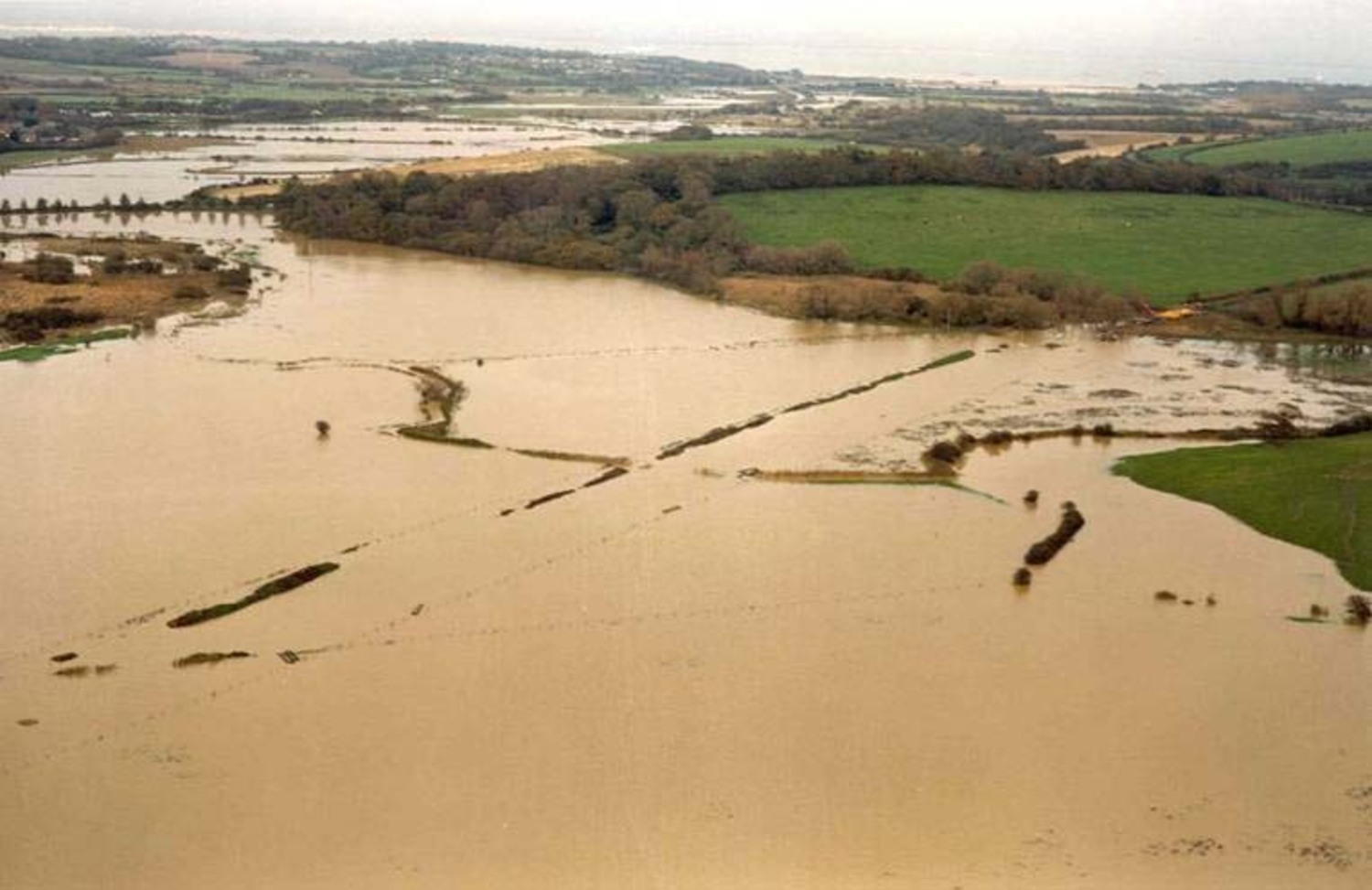 Ben - You said that this has been an area of research for a while. Before we started developing sensor networks, how were we studying it? What tricks were we using?
Ben - You said that this has been an area of research for a while. Before we started developing sensor networks, how were we studying it? What tricks were we using?
Anne - Yes, so people have been studying this area because there are some gravel pits at the north of this meads and people were worried that with the extraction of gravel that the groundwater would actually change, so they were worried it would drop and therefore that some species would actually disappear. So, various institutes and also botanists from the Open University started to look at this site and they, as we still do, would look at the species so we would quantify how many species we have. But also in the past, they would put one or two data loggers in this field and measure soil moisture. Maybe they would come back weekly and they still come back monthly for example to measure groundwater levels. But now, we want to measure this at a much wider spatial and temporal scale so that we can measure every half hour so that when we have a flood or when the groundwater does come up after a heavy rain storm, we're actually measuring it and we can see what's happening.
Ben - Presumably, as it's an area of specific scientific interest, you can't just go around, dig a hole in which to put your sensor and then dig another 10 holes for another 10 sensors. You must be to adapt them to be a non-invasive as it where.
Anne - Yes, so this is where the real special challenge is for our project, for what we call the FUSe project, Floodplain Underground Sensors. The key is really in the word 'underground'. We try to keep our sensors underground, obviously because we're measuring soil variables, but also, our nodes are little signal transmitters. We're trying to keep those, or we want to keep those, and we need to keep those underground, because we don't want visitors tripping over it. We also have cattle grazing here, during certain times of the year, and because this is a hay meadow there will be harvesting happening in the middle of summer, and we can't have the harvesting vehicles driving over our nodes. So we have the challenge that we need to get a signal from the sensors or from these nodes out to the soil. This is actually very hard because radio signals don't travel at all well through soil especially when the soil is wet, and when it has a lot of clay in it. So we've really chosen the most difficult site you could think of. It's a big challenge but we have some very good scientists from Imperial College who will be dealing with this problem with our help.
Ben - I assume you can't just essentially turn up the gain, just make them more powerful in order to get that bit further?
Anne - This is something we can do so, we're trying out different frequencies; they have all kinds of plans up their sleeves. One problem we obviously face is actually battery power because some of these sensors actually need some power before they can operate. So, if we want to keep those sensors underground for let's say, a year or two, this is a big challenge too to keep those batteries going.
Ben - And once you start collecting the data, so once you get this regular update, this near real time input on a high resolution from these floodplains, what can you start to do with that data?
Anne - Other than just looking at this data and studying how for example soil moisture content varies over the site, and we're hoping to have about 50 nodes placed over the field, we're also going to incorporate this data into an environmental model where we describe plant and soil processes through mathematical equations. But at the same time, we're going to pull in into that model high resolution Earth observation data so that we can not just work out what's happening at these 50 subsites over our field where we have our sensors, but actually, we can start upscale with these Earth observation data that may go down to about half a meter resolution, we can actually try to then make a map of what's happening to the vegetation, how healthy it is, whether it is water stressed or probably air stress that it's actually too wet. So we can really start to work that out from a combination of remote sensing data, model data, and this in-situ wireless sensor network data.
Ben - And when do you expect you'll have all of your test done? When are you actually going to roll it out?
Anne - Well, we have done some tests and we're going to do more tests in April. So hopefully, let's say the middle of summer, the end of summer, we will have some nodes in and we will be testing it. The project started for some us last April so it's now nearly 1 year in, but the Imperial College team actually started slightly later with some of their scientists working on this problem. So, I would say we have another 3 or 4 months before we have something happening.
Ben - Well we look forward to getting you back on the show to tell us what you've been finding!
Anne - Certainly, I'm looking forward to this.
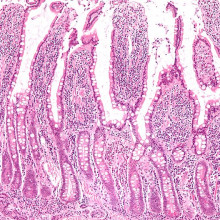
16:50 - Gut Bugs Promote Blood Vessel Growth
Gut Bugs Promote Blood Vessel Growth
The bacteria that live in your intestines change the way that blood vessels form inside your gut. New research, published in the journal Nature, identifies how this happens and offers potential new targets for treating intestinal diseases and obesity.
There are more bacterial cells in your body than human cells, but they are not mere passengers or parasites. Healthy intestinal flora helps to educate the immune system as well as playing an important role in vitamin production and absorption of nutrients. Disturbed or unbalanced gut flora is known to be associated with disease, such as inflammatory intestinal disease, obesity and allergies.
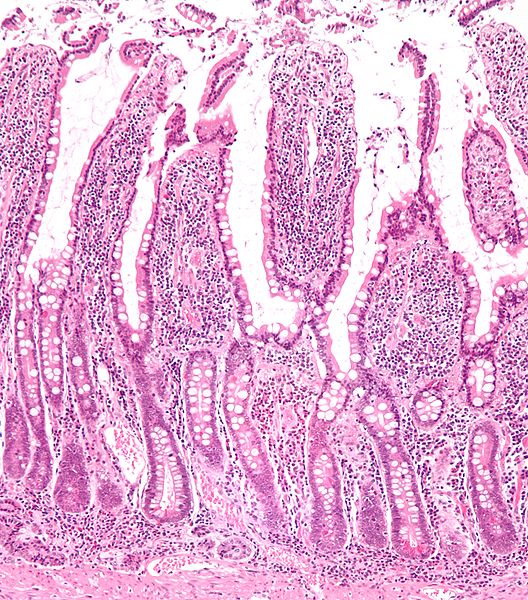 The inside of the intestine is lined with villi -protrusions that increase the surface area and therefore the amount of nutrients that can be absorbed. When mice are bred in germ free environments, and so have no bacteria in their gut, these are long and narrow, but introducing bacteria causes the villi to become significantly wider and increases the density of blood vessels nearby. This suggests that the presence of bacteria can modify the absorptive capacity of the gut.
The inside of the intestine is lined with villi -protrusions that increase the surface area and therefore the amount of nutrients that can be absorbed. When mice are bred in germ free environments, and so have no bacteria in their gut, these are long and narrow, but introducing bacteria causes the villi to become significantly wider and increases the density of blood vessels nearby. This suggests that the presence of bacteria can modify the absorptive capacity of the gut.
Now, Fredrik Bäckhed at the University of Gothenburg and colleagues in Sweden and Germany have identified three factors responsible for this effect - Tissue Factor (TF), Protease-Activated Receptor 1 (PAR1) and Angiopoietin-1 (Ang-1), all of which are known to be involved in blood vessel creation and proliferation.
The presence of bacteria leads to a sugar molecule being attached to the surface of the Tissue Factor protein, which then causes it to migrate to the surface of the cell, where it signals to other factors to start creating blood vessels. This increases the density of local blood vessels and alters the amount of nutrient that can be absorbed across the intestine wall. Altering these pathways, therefore, could lead to the ability to artificially modulate how the gut absorbs nutrients; a potential treatment for obesity and intestinal disorders.
Professor Bäckhed acknowledged that this is only a first step towards treatment, saying: "It will take time before the results can be applied in a clinical context and converted into new therapies. But our discovery is exciting, and is a result of fundamental basic research which teaches us a great deal about how we live in cooperation with the normal gut microobiota."

20:43 - You are (the colour of) what you eat
You are (the colour of) what you eat
Your daily fruit and veg intake discernibly dictates the colour of your face, new research has shown...
Scientists at the University of St Andrews in Scotland began by asking 35 students to complete questionnaires logging their average daily intake of fruit and vegetables. These individuals, the data show, consumed a modestly healthy 3.41 fruit and vegetable portions per day.
Next, at three and six week time-points, the students' faces and other skin areas were imaged, the colours analysed and the results compared with the diet records.
Changes in fruit and vegetable intake during the study period, the St Andrews team found, were reflected in skin colour changes in the participants. Specifically, changes were seen in colours corresponding to the carotenoid antioxidants with which vegetables and fruits are richly endowed.
But were these changes perceptible to a person, or merely to a sensitive camera? To find out, Ross Whitehead, the lead author on the study which is published this week in the journal PLoS One, showed a second group of volunteers pairs of images prepared from four faces.
These had been manipulated to add increasing amounts of yellow colouration to the skin over a series of 22 otherwise identical images of the same face. This colour difference would have corresponded to a variation in intake of 5.55 daily portions of fruits and vegetables.
The study participants were asked to rate pairs of images of the same face as more or less healthy. Initially they were shown faces at each end of the 22-face spectrum; if they chose correctly, faces progressively nearer to one another on the colour spectrum were presented.
The subjects could discriminate a colour difference equivalent to consuming 1.89 more, or fewer, portions of fruit and veg per day.
This ties in with what has already been observed in other human studies: people rate yellower faces as more healthy and given free rein to digitally manipulate photos of faces, most people add extra yellow, mimicking the effect of extra betacarotene, the orange chemical in carrots.
The results also resonate with what goes on in the natural world. Dietary antioxidants alter animal colours and this can be used by potential partners as a measure of an individual's health and likely mating prowess. Individuals with a good diet, healthy lifestyle and antioxidants to spare can afford to spend some on making their skins look a nice colour! Humans, it seems, are no different.
So, rather than a fake tan and a nose job, the way to pull, it appears, is instead to reach for your banana and a healthy helping of nuts...
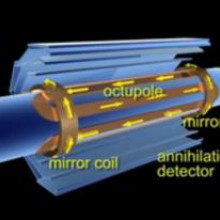
25:55 - Analysing Antimatter with Microwaves
Analysing Antimatter with Microwaves
with Professor Jeffrey Hangst, CERN
Ben - Scientists have taken the first steps towards interrogating anti-matter and find out more about this mysterious material. It sounds like the stuff of science fiction but anti-matter is a reality. It can be made in the laboratory and it's even used in medical imaging during things like PET scanning. It is something of an enigma though, the rules of physics say that there should be at least as much anti-matter in the universe as there is normal matter - the matter that we're made from - but scientists can't find it, suggesting either that we've got something wrong in our basic physics or that something else very exciting and important must be going on. The problem isn't trivial to study though because when anti-matter and normal matter come into contact, they annihilate each other and now, reporting in the journal Nature, scientists have made a very big step towards developing a way to measure anti-matter and this time, they're using microwaves. Chris Smith spoke to CERN scientist, Jeffrey Hangst.
Jeffrey - We're working on the ant-matter atom called anti-hydrogen. The simplest matter, or anti-matter atom you can imagine which consists of an anti-proton and a positron. We're at CERN in Geneva because we need the particle accelerator to produce the anti-protons, which is the nucleus of anti-hydrogen atom, positrons we get from a radioactive source. We've been working for a long time to learn how to put those two things together to make anti-hydrogen and that's what we'd like to study.
Chris - When you make some anti-hydrogen, how do you keep it in one place because it's not trivial to contain hydrogen in the first place? How do you keep anti-hydrogen which will just annihilate if it touches anything in something that you can study?
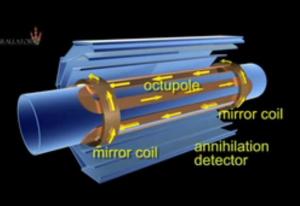 Jeffrey - Yes, it's a good question. It's actually easy to contain anti-protons which have an electric charge and positrons which also have an electric charge, but when you put the two together, you get a neutral atom, no charge. In order to contain that, we use very strong magnetic fields. The atom, the anti-atom, has a little bit of a magnetic character. So if you put in a very, very strong and inhomogeneous magnetic field, you can trap it. It's sort of a magnetic bottle. The problem is that in order to hold on to an anti-atom of anti-hydrogen, it has to be very, very cold. In our case, we can hold an atom if it's 0.5 degrees above absolute zero or less. So that's been the challenge that we only recently overcame - to hold on to these atoms once they're produced.
Jeffrey - Yes, it's a good question. It's actually easy to contain anti-protons which have an electric charge and positrons which also have an electric charge, but when you put the two together, you get a neutral atom, no charge. In order to contain that, we use very strong magnetic fields. The atom, the anti-atom, has a little bit of a magnetic character. So if you put in a very, very strong and inhomogeneous magnetic field, you can trap it. It's sort of a magnetic bottle. The problem is that in order to hold on to an anti-atom of anti-hydrogen, it has to be very, very cold. In our case, we can hold an atom if it's 0.5 degrees above absolute zero or less. So that's been the challenge that we only recently overcame - to hold on to these atoms once they're produced.
Chris - Is that because if you were to raise the temperature at all, then the atoms would have too much kinetic energy? They'd be moving too fast and that would make it very difficult to hang on to them? So by cooling them down, you slow them down, and it's easier to keep them in that flask.
Jeffrey - We actually have to produce them cold. They're produced in the magnetic bottle and if they're not moving too fast, they'd stay there. The whole idea is to start with them cold. We can't cool them down after their formed. If you think of it as a marble rolling in a bowl, if the marble is rolling too fast, it will go over the lip of the bowl. In our case, the marble, the anti-hydrogen atom is produced inside the bowl with some velocity. If that velocity is too high, it just rolls out and annihilates. So the whole trick is to produce it cold in the first place because we don't have any way to cool it down after it's made.
Chris - And now you know that you can make them and you can keep them in a stable state for a thousand seconds, the question is, how do we study them?
Jeffrey - When we do this experiment, we have on the average, one atom at a time of anti-hydrogen. That's not a lot. You could never do an experiment with only one atom of a matter at a time. So what we do now, I mentioned that it is a magnetic interaction that holds the atoms in the magnetic bottle. Let's go back to the bowl analogy. Think of the atom as a compass needle on a microscopic scale. If that compass needle was pointing in the correct direction with respect to this magnetic field, it wants to stay in the bowl. If you flip that little compass needle in the opposite direction, it's suddenly as if you put the marble on top of an upturned bowl and it just wants to roll away. So what we do in this experiment is we shine some radiation, some microwaves onto the trapped atoms and if you get the frequency of those microwaves exactly right, it'll flip the magnetic direction of the atom. So it goes from wanting to be trapped in this magnetic bowl to wanting to roll out. When it does roll out, it hits some matter in the walls of our device and annihilates. So, we tune our microwaves, make the atom fall out, and then detect that it annihilates. We're very good at detecting that annihilation on a microscopic scale. It releases a lot of energy and we can see one atom.
Chris - What is that actually telling you about the structure of the anti-hydrogen? Are you able to do the analogous experiment with hydrogen and then say, "Well, look. It interacts with microwaves in exactly the same way"?
Jeffrey - Yes, so what you'd learn is for example, how strong is this magnetic character of the particles that make up anti-hydrogen? And those are fundamental constants. We call them the spin and magnetic moment of the particles. We know very, very well the spin or the magnetic moment of the proton and of the electron and also, the positron, it's been measured independently. What we get at with this one is the magnetic size, if you will, of the anti-proton. That's something that isn't known very well today, only to about a few parts in a thousand where in atomic physics, a good measurement is one part in 10 to the 15, that's 1 with 15 zeros after it. So, we're just starting to measure this type of atom. That's the kind of precision that people have on other measurements in hydrogen. So, we're looking to compare the fundamental constants that characterise anti-matter and see if they're the same as the very, very well measured one in hydrogen.
Chris - One of the other big outstanding questions is of course, where all the anti-matter has gone in the whole universe. This, if you can work out how to measure anti-matter and spot it in the characteristic or finger print way, means that you can then turn your looking glass on the universe at large and ask that question, where is all the anti-matter?
Jeffrey - It's not clear that we'll be able to directly address that question. Supposing we do find a difference between hydrogen and anti-hydrogen, it may or may not point in some direction that could help us understand the evolution of the universe. There's no theory right now that says, what such difference might look like or how it might manifest itself in a particular measurement. So, our philosophy is, we have this huge puzzle. Anytime you can get your hands on some anti-matter, you have a moral obligation to go and look very carefully. So that's what we're doing. If there is a difference, it'll be up to some theorists to sort that out and I'd look forward to that.
Ben - And we will look forward to hearing about this. That was CERN scientist, Jeffrey Hangst, talking to Chris Smith.

33:55 - Happiness is in your Right Hand
Happiness is in your Right Hand
How you type a word could change the way you emotionally respond to it, and words typed with mainly the right hand seem to make people happier. In fact, the layout of letters on a keyboard may even be shaping the way we use language.
The qwerty keyboard, named after the first 6 letters on the first row, was invented in 1868, and designed to keep commonly used letters apart so as to avoid the clashing and jamming that was possible with mechanical typewriters. Although we no longer rely on the same mechanical processes to type, the keyboard layout has remained the same and is now ubiquitous.
 Writing in the journal Psychonomic Bulletin & Review, Kyle Jasmin & Daniel Casasanto devised a set of experiments to test people's emotional response to certain words. Previous research has shown the performing motor actions, such as typing, in a fluid way leads to positive feelings, so if typing is more fluent with one hand than the other, it could lead to a bias in emotion towards words typed with that hand.
Writing in the journal Psychonomic Bulletin & Review, Kyle Jasmin & Daniel Casasanto devised a set of experiments to test people's emotional response to certain words. Previous research has shown the performing motor actions, such as typing, in a fluid way leads to positive feelings, so if typing is more fluent with one hand than the other, it could lead to a bias in emotion towards words typed with that hand.
To test this, volunteers were asked to rate how positive or negative they feel about a sample of around 150 words. The experiment was done in three languages - English, Spanish and Dutch, with native speakers for each language, and a second test included newer words and internet acronyms such as LOL.
The results showed that words with more letters from the right hand side of a qwerty keyboard produced a significantly more positive emotional response - regardless of language and the volunteer's handedness. Furthermore, the effect was even more pronounced in modern acronyms and words created since the invention of the qwerty keyboard.
To further test this idea, Jasmin and Casasanto wanted to know if keyboard bias would allow them to predict how positive people would find made up words, known as pseudowords, which have no inherent meaning that may alter emotional response. Again, words with a right-hand bias were deemed to be significantly more pleasing.
The authors conclude that there truly is a bias towards feeling good about words typed with the right hand, and argue that this could be because the layout of the qwerty keyboard provides the right hand with an easier job. They also suggest that this could have an impact on marketing, saying:"People responsible for naming new products, brands, and companies might do well to consider the potential advantages of consulting their keyboards and choosing the "right" name."
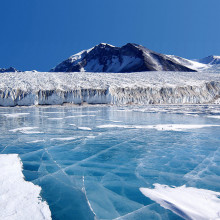
37:54 - Antarctic Invasion and Chimp Cops!
Antarctic Invasion and Chimp Cops!
with Steven Chown, Stellenbosch University; Alejandro Frangi, INSIGNIO; Markus Knarden, Max Planck Institute for Chemical Ecology; Carel Van Shaik
Antarctic Invasion
Alien plant species are
invading the fringes of Antarctica through seeds brought in by scientists and tourists visiting the region.
Steven Chown from Stellenbosch University searched for seeds attached to the bags, boots and clothing of Antarctic visitors , calculating that 70,000 seeds in total were brought in over a one year period.
 Invasive species are already established along the western Antarctic peninsula and it's feared that if the climate warms as predicted, these plants as well as new seeds arriving on the scene could flourish.
Invasive species are already established along the western Antarctic peninsula and it's feared that if the climate warms as predicted, these plants as well as new seeds arriving on the scene could flourish.
---
Revealing all at the Hospital
A new virtual human could help personalise medical treatments in the future.
By combining height, weight and medical history data with scans and X-rays, engineers have developed a computer program that can model the cardiovascular system.
Ultimately the aim is to model the entire body, helping clinicians to test and predict, non-invasively, drugs, treatments and medical procedures before using them.
Alejandro Frangi is the director of the UK's INSIGNEO Institute for Biomedical Imaging and Modelling, which opened this week...
---
Homebound Ants sense plumes of CO2
Plumes of carbon dioxide released from ants nests help workers find their way home after they've been out foraging for food.
By recreating these plumes, Max Planck Institute for Chemical Ecology scientist Markus Knaden showed that Tunisian desert ants are up to
75% more successful at locating their nest sites compared with when the plumes weren't present. This suggests that they use this approach to avoid spending too long hunting for home in the oppressive desert heat...
---
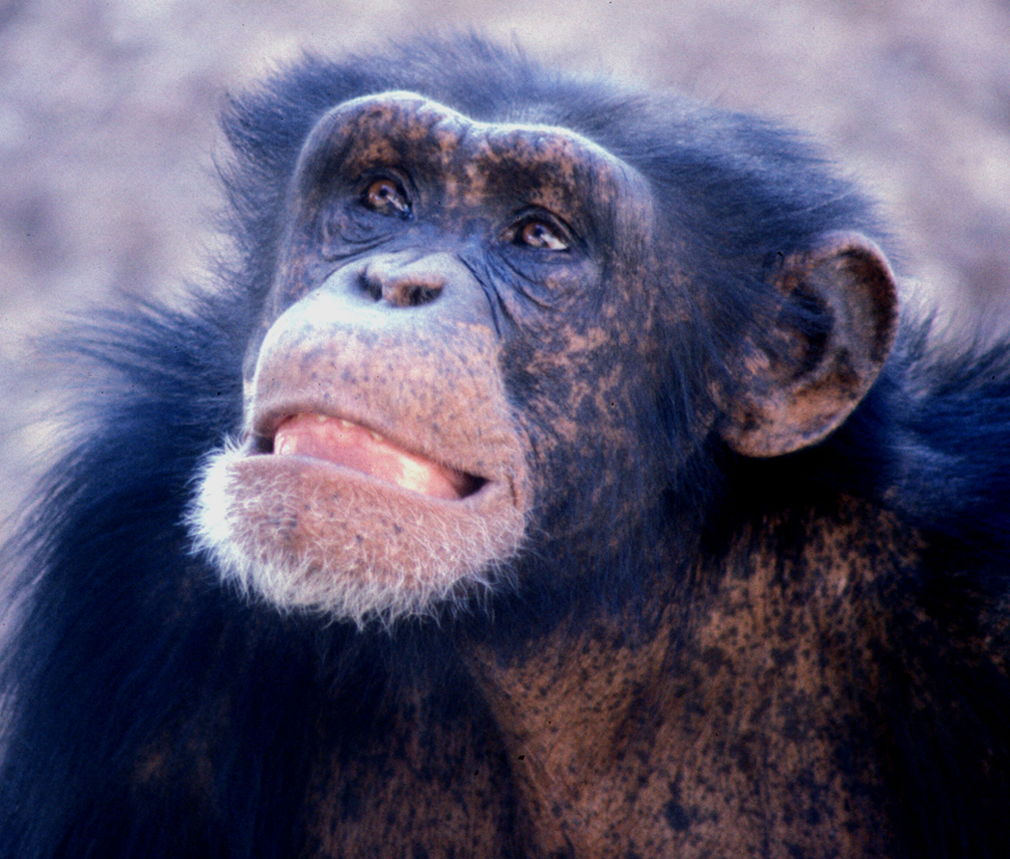 Chimp Cops
Chimp Cops
And finally, chimpanzees have police that step in and break up fights within their social groups.
Monitoring chimp behaviour in a range of groups and locations, Carel Van Shaik (Shike) from Zurich University found that although conflict is rare, when fights do arise within a group, a chimp impartial to the situation will step in to ease the tension. And they do this purely to restore peace and stability within the group rather than for any personal gain.
Crucially, gender and social rank were irrelevant to the policing role and the team think this points to the origin of the human moral code and conscience...
And that work was published this week in the journal
PLoS ONE.
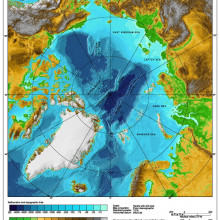
42:03 - The Bulging Arctic Ocean - Planet Earth Online
The Bulging Arctic Ocean - Planet Earth Online
with Dr Katharine Giles, Centre for Polar Observation and Modeling at University College London
British scientists recently used satellites to discover a bulging dome of fresh water in the Arctic Ocean....and it's getting bigger.
The lead author of the study was Katharine Giles from the Centre for Polar Observation and Modeling at University College London. Planet Earth podcast presenter Sue Nelson caught up with Katharine to find out more about this fresh water dome and why it's important...
Katharine - Well, if you imagine you're looking down on the Earth, over the north pole and you can see the Arctic ocean, if you cast your eyes over to Canada, then go north of the Canadian coastline then you're in the Beaufort Sea. In the Beaufort Sea there's a circulation system called the Beaufort gyre, that's a rotating dome of water that rotates in a clockwise direction and what we've seen from the satellites is that dome increasing in height. The area is over 1000 kilometres across, so that's the distance between roughly, say, London and Venice, so it's quite a large area of the Arctic Ocean.
Sue - And when you say a dome, are we talking like a huge "Millennium Dome" rising of water above the sea surface?
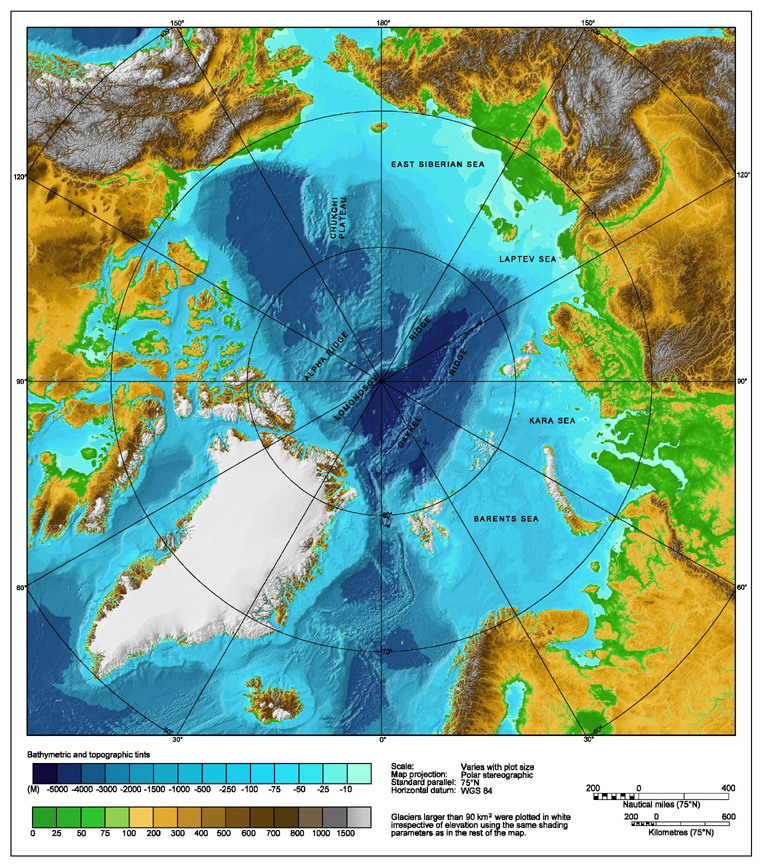 Katharine - I imagine it more like a contact lens rather than a Millennium Dome, but it's still quite a large amount of water, it's about 8000 cubic kilometres of fresh water which is roughly 10% of all the fresh water that's stored in the Arctic Ocean.
Katharine - I imagine it more like a contact lens rather than a Millennium Dome, but it's still quite a large amount of water, it's about 8000 cubic kilometres of fresh water which is roughly 10% of all the fresh water that's stored in the Arctic Ocean.
Sue - Now, did you have clues that there was this body of fresh water in among a salty ocean?
Katharine - Well yes. Measurements taken from ships and moorings have shown that there has been an increase in fresh water over the past 15 years or so. But it is really difficult to make measurements in the Arctic because of the cold, dark winters and the ocean itself is covered by a layer of frozen seawater so it makes it hard for the ships to break through. This is why this satellite data is really useful. It helps to tie these snapshots of data taken from the ships and from the moorings to give us an idea of the overall picture of how the Arctic Ocean is changing.
Sue - Now you were using two European Space Agency satellites, ERS2 and Envisat. Were they both looking at the saltiness of the ocean or sea surface height in order to work out that, hold on, we've got this enormous of fresh water in the Arctic?
Katharine - What these satellites do - we use an instrument on board them called a radar altimeter and what that does is measure the elevation or the height of a surface. So, the data we're using is actually looking at changes in the sea surface height and from that, combining it with data from another satellite called Grace which measures changes in mass, we can estimate the change in the fresh water.
Sue - Is there a possibility that this fresh water could flow into other circulatory systems around the Earth?
Katharine - What we've seen in our data is that, with the fresh water that has been stored over the past 15 years, the winds seem to be controlling that storage of fresh water. So it's possible, if the winds then change direction, then that fresh water could be released out into the western Arctic, to the rest of the Arctic Ocean or beyond. And we're interested in that because changes in fresh water leaving the Arctic Ocean can influence the deep convection in the North Atlantic.
Part of the reason that Northern European enjoys a relatively mild climate in the winter is because of heat transported by currents that are derived from the Gulf Stream. So this circulation system, we call the global overturning circulation system, and that's bringing heat from lower latitudes up to the north in the ocean currents. As that water reaches the north it cools, it releases its heat to the atmosphere and the cooler water then sinks and more water moves up to take its place. This is a density driven circulation. The water is sinking because it's more dense, so if you then add less dense fresh water from the Arctic possibly you could effect that circulation system. In the past we've seen than an amount of water of a similar size to this 8,000 cubic kilometres may have influenced this convection in the Labrador Sea, which is one of the areas in the North Atlantic where you get this kind of overturning circulation. Whether that had an effect on our climate is something that we don't know.
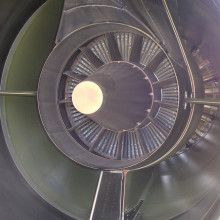
47:02 - Sensing Inside a Jet Engine
Sensing Inside a Jet Engine
with Graeme Rigg and James Kell, On-Wing Capability Team, Rolls Royce.
Ben - We return now to our topic of sensors and sensor technology. But rather than sensing a natural system such as the soil or the atmosphere, we're going to explore the technology needed to see inside a very man-made environment, a jet engine. Rolls Royce engines are regularly inspected to keep them in tiptop condition and running efficiently. The job of getting inside to check them over falls to the on-wing capability team. I met James Kell who develops the tools and manager Graeme Rigg.
Graeme - Our key challenge really inside an aero engine is the fact that generally, the access ports to get inside are very small, sub 9.4 mm. The route through blades and vanes are quite torturous sometimes if you want to view something that's none routine. Also, the engine runs at very high temperatures so we've got quite a hostile environment as well. So if we want to leave something permanent in there to monitor, that's always going to be difficult. So we try and inspect the engine when it's on the ground, and when it's cooled down.
Ben - Why do we need to avoid just taking the engine off, opening it up, stripping it down, checking it all out and then putting it back on?
Graeme - One of the key things we're here for is to keep engine on-wing as long as possible. It's very costly to remove an engine from wing. It's very disruptive to the customer. One of the key things is that an aircraft has a schedule and might have 300 people waiting to fly out somewhere, and if it's stuck on the ground, then that's obviously quite serious and quite disruptive. So we want that engine in perfect condition so that they can take off on schedule, at the right time, and keep the customer happy.
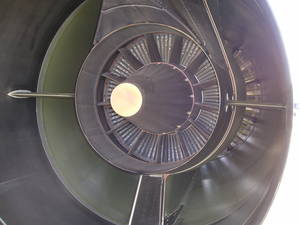 Ben - So how does this on-wing testing using these tiny access ports, how does that fit in with the general life of an engine?
Ben - So how does this on-wing testing using these tiny access ports, how does that fit in with the general life of an engine?
Graeme - There is always schedule maintenance of engines, so they're removed periodically and put through the overhaul facilities where they're stripped down to detailed parts and completely refurbished. The bit that we're interested in is whilst they're on the wing, in between those periods, so that we can make sure that the engine is in its optimum operating condition, we don't cause any delays and that we can actually see inside the engine and monitor the condition of it.
Ben - What are the sorts of things that we actually need to monitor inside an engine?
Graeme - Generally, we're looking at the rotating components so that'll be the compressor blades and turbine blades. We can inspect those using our borescope equipment.
Ben - It sounds that you actually have a lot in common with surgery and in particular keyhole surgery where you need to do very delicate procedures through tiny access holes. Can you share some of the technology?
Graeme - A lot of the technology we use is developed from surgery from the medical industry. A lot of the companies we use predominantly are medically based. We use borescope equipment or enteroscopes, so we can actually see through a camera inside the engine, and see rotating components to make sure that they perform as they should. At other times, we have to go in and we have to clean things, we look inside oil systems sometimes to make sure there's no carbon. There's the routine areas which will be the gas stream which is turbine and compressor blades and then there's non-routine things which is where it becomes more surgical and more difficult because the routes in are always very difficult, and sometimes have to go in through pipes and other components.
Ben - With surgery of course, we can make an incision where we need to in order to go in and access things. With an engine, I guess, once it's built and once those access ports have been put in, then we have no choice but to use those. Does this get thought about in the initial design? Are you pushing to make sure that you'll have the access you need?
Graeme - Yeah, we sit in the design meetings and we specify that we would like access to both sides of each turbine and compressor blade. Sometimes due to the complexity of the design, that's not always possible and that's where we have to develop specialist techniques to get into more difficult areas. We do feed in to design and we are having more influence as we have more techniques and people can see the importance of what we do.
Ben - Beyond the technology borrowed from surgery and dentistry, what have you had to develop in order to meet your challenges?
Graeme - I think sometimes the means of getting there, so we have the vision systems, but sometimes it's actually getting something into the area that we need to get to. So it's often using specially made guide tubes and bespoke equipment to actually help drive the equipment to where it needs to go.
Ben - So when there isn't a tool that already exists, you're forced to develop a new one and actually build something that fits the situation.
Graeme - Yeah, and I think that's the beauty of the job really that we're given the problem, we go to a training engine and we look at the access, we work out how we're going to do it, we make prototype tooling and obviously see if it works in the engine. If it does then we train teams up to go out and deliver the service.
Ben - James, your job is more on the R&D side of this actually, developing the new tools. What sorts of challenges do you face?
James - It's similar to Graeme in effect that we've still got the same environment that we're looking at, but it's my job really to monitor the technology that's out there to start with. If we've already got something that's almost developed and it's not quite to our needs, we can maybe modify it so that we can use it in the same environment. So that means, I'm looking at things like medical conferences and journals for that kind of thing, and also robotics, and the conferences and journals on that as well.
Ben - It seems that you have the full range of the world of science and engineering to pick from in order to find the right tool.
James - The idea, in a way, is to try and maybe in 50 years, we'll be able to miniaturise the whole of the maintenance and overhaul facility and be able to do all of those things whilst the engine is still intact. Obviously, that's quite a way ahead and there's always going to be some things that we can't do whilst the engine is still in one piece. But I think the idea is really to look at things that are out there and develop those things so that they can be used. So there's all sorts of things that we're trying to use and laser technology is one of those areas that we're investigating quite heavily and also robotic equipment. So the idea is to try and brush your teeth when you're in the upstairs bathroom if you're stood at the letter box outside.
Ben - So how does the process work? Graeme would say to you, "I need to find a way of getting to this particular component." How do you then step into action?
James - There are two different ways I might get involved. There's me thinking of a blue sky wacky idea, floating it past Graeme, seeing whether he thinks it's got merit (and he's shaking his head at me). The other option is for some problem that we know is coming down the line for example in an engine that's being built at the moment but not necessarily in service, where we've got the luxury of perhaps a year or two to actually develop a technique. A good way of thinking of it is we've got a push of technology where I think of a blue sky idea or we've got a technology pull where people like Graeme know there's a problem out in the world and we got to try to think of a way of solving it.
Ben - So, in the future, what would you hope to see to make your life easier, to make these developmental tricks easier?
James - The ultimate thing for us would be an engine that you could take apart and still not have to worry about going in through a very small hole which is around 9 mm. You can maybe lift off a panel and expose a whole array of different components. That's a significant design challenge and probably not one that we can entertain anytime soon.
Ben - And Graeme, what do you see as being the tools of the future that you would really like to see developed?
Graeme - I think James eluded to this already in terms of laser type technology and miniaturised robotics. I think they are the two key areas that we're looking to invest in and develop.
Ben - Graeme Rigg and before him James Kell, both from the on-wing capability team at Rolls Royce.

54:52 - How would I know if a meterorite was falling towards me?
How would I know if a meterorite was falling towards me?
We put this question to Dr Mark Lewney, who gained his PhD in Acoustics from Cardiff University... Mark - For most of us here on the Earth's surface, the speed of sound is around 340 m/s or 750 miles an hour. That's one mile every 5 seconds which is actually not all that fast. It's only about twice the speed of the fastest arrows in archery. Sound is also even slower in colder air and the air altitude is both colder and much less abundant.
So when the meteoroid, the lump of rock itself enters the atmosphere 100 km up and becomes a meteor, it will always be too far away to hear. It's possible that its electromagnetic waves travelling a million times faster than its sound waves will cause a hissing noise in phones or radios, but even this so-called electrophonic effect is debatable.
But Daniel asks not about a meteor which burns up in the atmosphere but a meteorite which actually makes it all the way through the atmosphere to the Earth's surface. Would this give any warning? Sadly, no. It will be travelling at least 11,000 metres a second, 33 times the speed of sound, far too fast to hear its approach. In fact, we probably wouldn't be able to see it either. Only a tiny fraction of the solar system's asteroids are currently being tracked by just a handful of volunteers worldwide. So unless it reflected the light in just the right way in a small region of the sky that someone happened to be looking at very carefully, it would almost certainly be too small and too fast to see until it entered the atmosphere just a few seconds before impact. I'm afraid Daniel's final moment would be rather disappointing.
Hannah - Poor, Daniel. Mark adds that it is possible that the meteorite will burn up just enough to be decelerated by the atmosphere to subsonic speeds. But that this would leave a meteorite so tiny that getting killed by it would be a bit embarrassing.










Comments
Add a comment